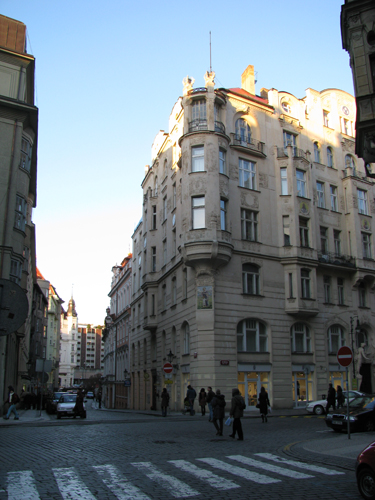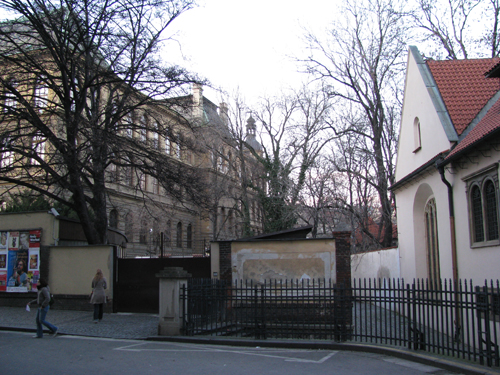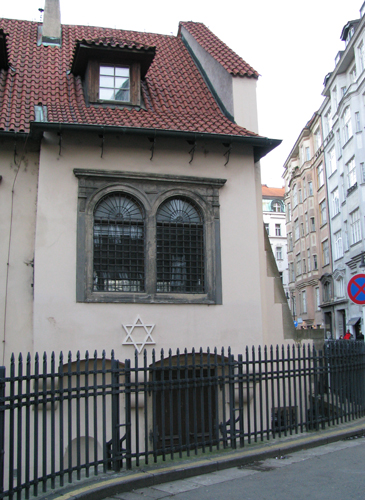In the
Middle Ages there were two distinct Jewish communities in Prague's Old
Town. Jews from the west had settled around the Old-New
synagogue, Jews from the Byzantine Empire around the Old Shul (on the
site of today's Spanish Synagogue). The two settlements gradually
merged and were confined in an enclosed ghetto. For centuries
Prague's Jews suffered from oppressive laws--in the 16th century they
had to wear a yellow circle. Christians often
accused them of starting fires and poisoning wells--any pretext for a
pogrom. Discrimination was partially relaxed in 1784 by Joseph
II, and the Jewish Quarter was named Josefov after him. In 1850
the area was officially incorporated as part of Prague. In the
1890's the city authorities decided to raze the ghetto slums because
the area's complete lack of sanitation made it a health hazard.
However the Town Hall, a number of synagogues and the Old Jewish
Cemetery were saved.
|
When it was first built, at the end of the
16th century, the Maisel synagogue was a private house of prayer for
the use of mayor
Mordechai Maisel and his family. Maisel had made a fortune
lending money to Emperor Rudolph II to finance wars against the Turks,
and his synagogue was the most richly decorated in the city. The
original building was a victim of the fire that devastated the Jewish
Town in 1689 and a new synagogue was built in its place. Its
present crenellated, Gothic appearance dates from the start of the 20th
century.
|
 |
|
The core of this attractive pink and white building is the original
Jewish Town Hall, build in 1570-77 by the immensely rich mayor,
Mordechai Maisel. In 1763 it acquired a new appearance in the
flowery
style of the Late Baroque. The last alterations date from 1908
when
the southern wing was enlarged. The town Hall is now the seat of
the council of Jewish Religious
communities in the Czech Republic. |
On the roof stands a small wooden clock tower with a distinctive green
steeple. The right to build the tower was originally granted to
the Jewish community after their part in the defence of Charles Bridge
against the Swedes in 1648. On one of the gables there is another
clock. This one has Hebrew figures and, because Hebrew reads from
right to left, hands that turn in an anti-clockwise direction.
|
The Old-New Synagogue was built around 1270, and is the oldest
synagogue in Europe and one of the earliest Gothic buildings in
Prague. The synagogue has survived fires, the slum clearances of
the 19th century and many Jewish pogroms. Residents of the Jewish
Quarter have often had to seek refuge within its walls and today it is
still the religious centre for Prague's Jews. It was originally
called the New Synagogue until another synagogue was built nearby--this
was later destroyed.
|
 |
 |
The Neo-Romanesque Ceremonial Hall along the outer wall of the Old
Jewish Cemetery.
|

The Pinkas synagogue was founded in 1479 by Rabbi
Pinkas and enlarged in 1535 by his great-nephew Aaron Meshulam
Horowitz. It has been rebuilt many times over the
centuries. Excavations have turned up fascinating relics of life
in the medieval ghetto, including a mikva or ritual bath. The
core of the present building is a hall with Gothic vaulting. The
gallery for women was added in the early 17th century. The
synagogue now serves as a memorial to all the Jewish Czechoslovak
citizens who were imprisoned in Terezin concentration camp and later
deported to various Nazi extermination camps. The names of the
77,297 who did not return are inscribed on the synagogue walls.
The building now houses an exhibition of children's drawing form the
Terezin concentration camp.
|

|